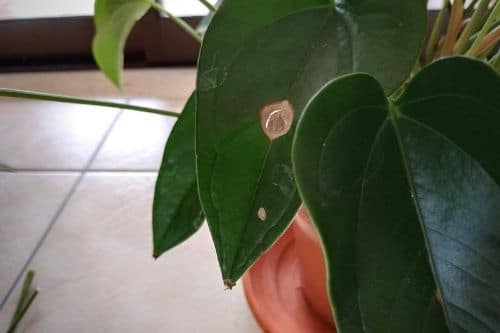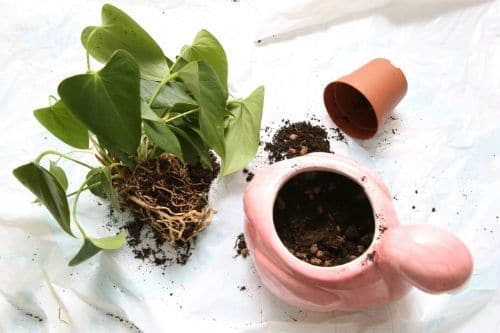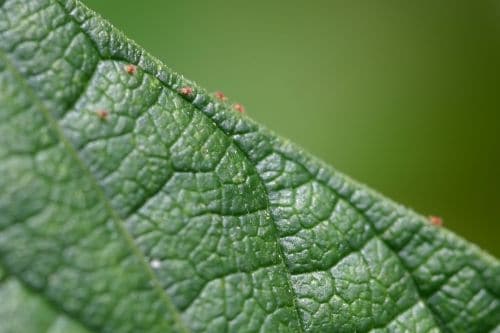Anthuriums are popular plants, but it’s important to know how to care for one and to realize when something is going wrong. If your Anthurium is not looking very healthy, you might be wondering what you should do and how to fix it.

The commonest reasons for these plants to develop brown spots include excess fertilizer, bacterial wilt, bacterial blight, mites, foliar nematodes, nutrient deficiencies, and too much sunlight. Determining which is causing issues can be a challenge, but it will be crucial to fixing the problem.
Reason One: Excess Fertilizer
Many proud owners of Anthuriums are keen to fertilize their plants to ensure they see rich, healthy, fast growth. Fertile soil can help to keep a plant healthy, ensuring it has everything it needs to build new leaves and stems. However, it is easy to get carried away and fertilize your plant too heavily.
This can lead to a buildup of nutrients and salts in the soil, which will alter the pH and may cause the plant’s roots to burn. If this occurs, the leaves will start turning brown. The salt will prevent the roots from absorbing water and nutrients, depriving the plant of food.
How To Fix It
If this occurs, you can either repot your Anthurium into fresh soil or wash the soil it is currently in. To wash it, stand your plant in the base of your shower or bath, and flush the soil out with lots of clean, fresh water. This will clear away the nutrients and salts.
Let your plant dry out a little and then return it to its usual position.
Reason Two: Bacterial Wilt
Like many plants, Anthuriums are vulnerable to diseases, and bacterial wilt is a common one that can cause brown leaves. This bacteria thrives in warm temperatures (over 90 degrees F) and it will attack your plant’s foliage, preventing it from developing new, healthy cells.
Usually, the leaves will start by turning yellow, and gradually become brown as the bacteria spreads. As the name suggests, you will also see the plant wilting, no matter how much you water it. This disease will progress and eventually kill the plant if you don’t address it.
How To Fix It
Unfortunately, bacterial wilt is a challenging problem to fix, and you need to act swiftly, catching it in its early stages. Remove diseased foliage, sterilizing your tools by dipping them into boiling water before every cut. Don’t let the diseased foliage touch the rest of the plant.

Change your plant’s soil and container, and disinfect everything with boiling water multiple times throughout the process. If you are going to use the same container, scrub it with soapy water and then soak it in disinfectant before you put the plant (or any other) in it.
You can also try phosphorus-based fungicides, as these may help with early-stage infections. However, bacterial wilt is difficult to deal with and will often kill a plant.
Reason Three: Bacterial Blight
Blight is also caused by warm conditions, and can quickly spread between plants, with any infected plant posing a risk to the others. It will start with blister-like bobbles on the leaves, which will turn yellow as the disease progresses.
They will turn brown a while later, and continue to attack the plant. Unfortunately, bacterial blight often kills Anthuriums, and it is contagious. Isolate infected plants immediately.
How To Fix It
This kind of bacteria often enters the plant through injuries, so make sure you are always using sterile tools when pruning your plant. Deal with insect infestations quickly, as these will leave open wounds that could expose the plant to the blight.
Some people recommend using both mancozeb and copper containing fungicides, and these should be applied regularly until the disease is gone. Again, ensure that you are sterilizing everything, including the plant’s container if you repot it.
Keep infected plants away from healthy ones and always wash your hands to prevent contamination.
Reason Four: Mites
Often, leaf browning is a result of mites or other pests nibbling at the leaves of your plants, causing damage to the cells and stress to the Anthurium. You should regularly check your plant for signs of pests, and deal with any that you find.
Mites such as spider mites are common on Anthuriums. They are attracted by dusty, undisturbed leaves, and they will crawl all over the plant, feeding on its leaves and stealing its nutrients. Spider mites often cause brown stripes across the leaves, so look out for this symptom and take quick action if you see it.

You can check whether your plant is infested with insects by inspecting its leaves closely. Most insects are visible. Aphids are small, winged insects that can fly from plant to plant. Mealybugs look like tiny balls of cotton wool. Scale insects appear as flat ovals pressed against the leaves.
Spider mites are challenging to see with the naked eye. Instead, slide a piece of paper under your plant and shake its leaves. If lots of dots appear on the paper, the plant has spider mites.
How To Fix It
You can fix mites and many other insect invaders by washing your plant in warm, soapy water. Rub the leaves gently between your fingers, and then rinse them. This should kill the majority of the mites. In some cases, just a blast of water will be enough to do it, given how small they are.
It may take a couple of treatments to completely rid your plant of mites. Keep it separate from other plants while you are treating it to prevent the insects from spreading.
Reason Five: Foliar Nematodes
In some cases, a tiny creature may start living inside the leaves of your Anthurium. The foliar nematode, sometimes known as the strawberry foliar nematode, tends to target young Anthuriums. It is a small roundworm that will cause thin stripes on the leaf’s surface, followed by brown areas mapped along the veins of the plant’s leaves.
The leaves will begin to turn brown and die as they are attacked, and the plant’s growth will slow or cease. A severe infection can kill a plant quickly if you don’t get on top of it, and you may see it shedding its foliage if it has this kind of infection.
How To Fix It
Again, this is a challenging problem to fix. Isolate your plant while you attempt to address it. Prevention is better than cure, so always use sterile tools when pruning your Anthurium, wash your hands before and after handling it, and keep its environment clean and free from mold.
The other way to reduce this nematode’s presence is to keep the leaves of the plant as dry as possible. Space the plants in your home out, rather than crowding them together, as this will promote airflow and help the leaves to stay dry. It will also minimize the risk of the pest spreading.
You can try using an insecticide soap to kill the nematodes, but as they are protected within the leaves, this may not prove effective. Cut off damaged foliage and keep the plant isolated and dry; it may recover. If not, you will have to replace it as little else can be done.
Reason Six: Nutrient Deficiencies
Sometimes, brown spots on an Anthurium will indicate that the plant is hungry and not getting the nutrients it needs to produce healthy green foliage. Brown patches may be accompanied by pale foliage and slow growth.

Think about when you last fertilized your Anthurium. Although you don’t want to give it too much fertilizer, too little will render it unable to produce new growth, so don’t completely neglect to fertilize it.
How To Fix It
If you think your plant is hungry, give it some diluted phosphorus-rich fertilizer once per month during its growing season. Pour this around the soil, rather than directly on the plant’s leaves or stems, and wash it in well so that the nutrients are carried down to the roots.
Remember that your plant needs water to take up the nutrients, so check that it has enough to drink. Avoid over-fertilizing, and reduce the frequency with which you fertilize when the plant is not actively growing.
Reason Seven: Too Much Sunlight
Anthuriums prefer to have indirect sunlight, and direct sun hitting the leaves is likely to damage them. If you put your plant too close to a window, it may start burning, and this will produce brown spots on its leaves and around the edges.
This will make your Anthurium stressed and could kill it if the exposure continues.
How To Fix It
Move your Anthurium away from the direct sunlight, or hang up a thin curtain to protect it. Cut away the damaged foliage using sterile shears so that the plant produces fresh leaves.
Conclusion
Anthuriums can suffer from a variety of issues that will cause stress and leaf browning, but if you’re aware of these, you can take prompt action. Good hygiene, clean leaves, and suitable conditions will protect your plant from many of these problems, and make it more capable of surviving if they do arise.

